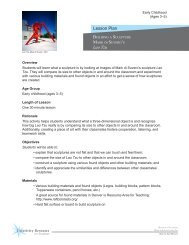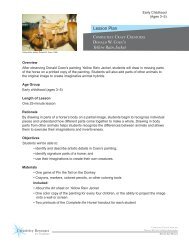Edward, Prince of Wales, later King Edward VI - Denver Art Museum
Edward, Prince of Wales, later King Edward VI - Denver Art Museum
Edward, Prince of Wales, later King Edward VI - Denver Art Museum
You also want an ePaper? Increase the reach of your titles
YUMPU automatically turns print PDFs into web optimized ePapers that Google loves.
<strong>Edward</strong>, <strong>Prince</strong> <strong>of</strong> <strong>Wales</strong>, <strong>later</strong> <strong>King</strong> <strong>Edward</strong> <strong>VI</strong><br />
Hans Holbein the Younger, 1538<br />
Overview<br />
Lesson Plan<br />
In PraIse <strong>of</strong> Me!<br />
Elementary<br />
(Grades K–5)<br />
Hans HolbeIn tHe Younger’s<br />
<strong>Edward</strong>, <strong>Prince</strong> <strong>of</strong> <strong>Wales</strong>, <strong>later</strong> <strong>King</strong> <strong>Edward</strong> <strong>VI</strong><br />
Students will learn about the history <strong>of</strong> the portrait <strong>of</strong> <strong>Edward</strong>, <strong>Prince</strong> <strong>of</strong> <strong>Wales</strong> and the inscribed<br />
praise poem. They will then write praise poems for their own portraits.<br />
Age Group<br />
Elementary (grades K–5)<br />
CMCS<br />
Visual <strong>Art</strong>s<br />
Standard 1: Students recognize and use the visual arts as a form <strong>of</strong> communication.<br />
Standard 2: Students know and apply elements <strong>of</strong> art, principles <strong>of</strong> design, and sensory and<br />
expressive features <strong>of</strong> visual arts.<br />
Standard 3: Students know and apply visual arts materials, tools, techniques, and processes.<br />
Standard 4: Students relate the visual arts to various historical and cultural traditions.<br />
Standard 5: Students analyze and evaluate the characteristics, merits, and meaning <strong>of</strong> works<br />
<strong>of</strong> art.<br />
Reading and Writing<br />
Standard 2: Students write and speak for a variety <strong>of</strong> purposes and audiences.<br />
Standard 3: Students write and speak using conventional grammar, usage, sentence structure,<br />
punctuation, capitalization, and spelling.<br />
Standard 4: Students apply thinking skills to their reading, writing, speaking, listening, and<br />
viewing.<br />
Length <strong>of</strong> Lesson<br />
One 50-minute lesson<br />
Rationale<br />
Making comparisons between the <strong>Edward</strong>, <strong>Prince</strong> <strong>of</strong> <strong>Wales</strong> portrait and photographic portraits <strong>of</strong><br />
themselves (and the praise poems that accompany the portraits) broadens students’ awareness<br />
that a work <strong>of</strong> art records and reflects the era in which it was made. It also teaches them that<br />
they can draw upon past work to inspire their own creativity.<br />
In PraIse <strong>of</strong> Me!<br />
Hans HolbeIn tHe Younger’s <strong>Edward</strong>, <strong>Prince</strong> <strong>of</strong> <strong>Wales</strong>, <strong>later</strong> <strong>King</strong> <strong>Edward</strong> <strong>VI</strong><br />
<strong>Denver</strong> art MuseuM
Objectives<br />
Students will be able to:<br />
Materials<br />
Lesson<br />
• state when the painting was made and describe three things about that era;<br />
• explain the purpose <strong>of</strong> the painting and the praise poem;<br />
• describe the difference between the <strong>Edward</strong>, <strong>Prince</strong> <strong>of</strong> <strong>Wales</strong> portrait and portraits <strong>of</strong><br />
themselves; and<br />
• use what they learn about praise poems to write one related to their own portrait.<br />
• One or more photographs <strong>of</strong> each child as a toddler or preschooler (brought from<br />
home)<br />
• A bag <strong>of</strong> Skittles or similar non-dairy candy<br />
• Lined paper and pens or pencils for each student<br />
Included:<br />
• About the <strong>Art</strong> sheet on <strong>Edward</strong>, <strong>Prince</strong> <strong>of</strong> <strong>Wales</strong>, <strong>later</strong> <strong>King</strong> <strong>Edward</strong> <strong>VI</strong><br />
• One color copy <strong>of</strong> the painting for every four students, or the ability to project the image<br />
onto a wall or screen<br />
1. Warm-up: Have students sit in a circle. Pass around the bag <strong>of</strong> Skittles and tell the<br />
students to take some. Encourage them to use their judgment when choosing how<br />
many Skittles to take, remembering that everyone needs to get some, and to not eat<br />
them until you say it’s okay. After all <strong>of</strong> the students have taken some Skittles, tell<br />
them that they have to share one thing about themselves for every Skittle they’ve<br />
taken. Start with yourself to model, and then go around the circle allowing everyone to<br />
share.<br />
2. Talk about how the students chose what to share. Did they share what was most<br />
important to them? Was it about who they are or their families? Was it about what<br />
they own or what they like to do?<br />
3. Show students the portrait <strong>of</strong> <strong>Edward</strong>, <strong>Prince</strong> <strong>of</strong> <strong>Wales</strong> and read the praise poem<br />
(found in the Things to Look For Section <strong>of</strong> the About the <strong>Art</strong> sheet). Discuss the key<br />
elements <strong>of</strong> the poem and talk about how the portrait reflects the sense <strong>of</strong> power<br />
and responsibility conveyed in the poem. What mattered to this family? What did the<br />
praise poem share that was different from what the students shared in the Skittle<br />
activity? What was similar?<br />
4. Tell students they are going to write a praise poem for the pictures <strong>of</strong> themselves<br />
that they brought in. The poem should reflect what the picture conveys. Should they<br />
receive praise for athletic prowess; creative clothing choices; an amazing sense <strong>of</strong><br />
humor; etc.? Should it focus on their family? Possessions? For younger students, you<br />
may want to write a praise poem as a class based on a class photo.<br />
5. Have students edit their poems with their peers before writing a final draft. Allow the<br />
students to display their portraits and read their praise poems to the class.<br />
In PraIse <strong>of</strong> Me!<br />
Hans HolbeIn tHe Younger’s <strong>Edward</strong>, <strong>Prince</strong> <strong>of</strong> <strong>Wales</strong>, <strong>later</strong> <strong>King</strong> <strong>Edward</strong> <strong>VI</strong><br />
<strong>Denver</strong> art MuseuM
<strong>Edward</strong>, <strong>Prince</strong> <strong>of</strong> <strong>Wales</strong>, Later <strong>King</strong> <strong>Edward</strong> <strong>VI</strong><br />
Hans Holbein the Younger, 1538<br />
About the <strong>Art</strong><br />
Hans Holbein tHe Younger’s<br />
<strong>Edward</strong>, <strong>Prince</strong> <strong>of</strong> <strong>Wales</strong>, <strong>later</strong> <strong>King</strong> <strong>Edward</strong> <strong>VI</strong><br />
Who Made It?<br />
Hans Holbein [HOLE-bine] the Younger was born in Augsburg, Germany, and is considered<br />
the most important portrait painter in England during the Reformation, a time when Christian<br />
ideals changed greatly. His father, Hans Holbein the Elder, was also an artist and gave Holbein<br />
his first art lessons. Hobein married and lived as an adult in Basel, Switzerland, but as the<br />
Protestant Reformation grew and religious images were being smashed and burned, it became<br />
increasingly difficult to succeed as an artist. Holbein moved to England, where his reputation for<br />
highly skilled and dignified portraiture preceded him, and he became the <strong>of</strong>ficial painter to <strong>King</strong><br />
Henry <strong>VI</strong>II beginning in 1536. In addition to painting royal portraits, he also traveled in Europe<br />
with a writer, assigned the unwelcome task <strong>of</strong> returning with portraits and written descriptions<br />
<strong>of</strong> potential brides for the king, to whom attractiveness was highly important. Through his<br />
meticulous technique, Holbein achieved remarkable realism in details and, despite his emotional<br />
remove, some sense <strong>of</strong> individual character. He died <strong>of</strong> plague in his forties, but his artistic<br />
influence was significant—English portraits were patterned on his style for almost a century after<br />
his death.<br />
What Inspired It?<br />
<strong>Prince</strong> <strong>Edward</strong> was about 14 months old when Holbein painted this portrait <strong>of</strong> him. <strong>Edward</strong><br />
was born to Jane Seymour, the third wife <strong>of</strong> Henry <strong>VI</strong>II, in 1537. When she died two weeks<br />
after giving birth, <strong>King</strong> Henry was devastated. In addition to getting all <strong>of</strong> his father’s affection,<br />
the prince received a rigorous education and carried the weight <strong>of</strong> his father’s expectations for<br />
him to succeed him on the throne and champion his cause <strong>of</strong> consolidating the Reformation.<br />
Though he was a frail child with weak eyesight and periodic deafness, he appears healthy and<br />
robust in his portraits. <strong>Edward</strong> was nine years old when he was crowned <strong>King</strong> <strong>of</strong> England and<br />
Ireland after his father’s death. Although guided by a council <strong>of</strong> advisors, <strong>Edward</strong> showed strong<br />
interest in religious policy, and just as his father had hoped, his reign furthered his father’s<br />
cause. <strong>Edward</strong>’s accomplishments were cut short, though, when he died <strong>of</strong> tuberculosis at the<br />
age <strong>of</strong> 15.<br />
Things to Look For<br />
Pose<br />
Holbein’s challenge was to make a baby look like a king. <strong>Prince</strong> <strong>Edward</strong><br />
sits up straight, looking down slightly at the viewer, and holds his hand up<br />
in an intelligent gesture <strong>of</strong> speaking, <strong>of</strong> benediction (like a bishop or Christ<br />
himself), or perhaps acknowledging the cheers <strong>of</strong> his adoring subjects.<br />
The young boy holds a golden rattle in his left hand, like the scepter he’s<br />
expected to hold one day. His control <strong>of</strong> his arms and head make him seem<br />
older.<br />
Hans Holbein tHe Younger’s <strong>Edward</strong>, <strong>Prince</strong> <strong>of</strong> <strong>Wales</strong>, <strong>later</strong> <strong>King</strong> <strong>Edward</strong> <strong>VI</strong><br />
<strong>Denver</strong> art MuseuM
Fancy Clothes<br />
<strong>Prince</strong> <strong>Edward</strong> is dressed in a very formal adult-like outfit. He is wearing<br />
a red velvet tunic and a fancy hat tied under his chin, both <strong>of</strong> which have<br />
elaborate gold details. The detail on his gold brocade sleeves shows <strong>of</strong>f the<br />
artist’s impressive control <strong>of</strong> his paintbrush.<br />
Setting<br />
Holbein has placed <strong>Prince</strong> <strong>Edward</strong> behind a parapet draped with a dark<br />
green cloth. This separates the space between the royal child and the<br />
viewer, and also creates the perfect spot to place an inscription.<br />
The Inscription<br />
The inscription at the bottom <strong>of</strong> the painting is a poem in Latin written by Sir<br />
Richard Morison. Translation:<br />
Little one, emulate thy father and be the heir <strong>of</strong> his virtue; the world<br />
contains nothing greater. Heaven and earth could scarcely produce<br />
a son whose glory would surpass that <strong>of</strong> a father. Do thou but equal<br />
the deeds <strong>of</strong> thy parent, and men can ask no more. Shouldst thou<br />
surpass him, thou has outstript all, nor shall any surpass thee in<br />
ages to come.<br />
Such inscriptions were not uncommon, especially for royal paintings like<br />
this one. The <strong>King</strong> commissioned the portrait not just to have a likeness<br />
<strong>of</strong> his son, but also to serve propaganda purposes, promoting his royal<br />
dynasty and his causes. The words flatter the king, communicate his power,<br />
and lend validity to his Reformation causes. They also convey the high<br />
expectations held for the child.<br />
Ostrich Feather<br />
The curve <strong>of</strong> the white ostrich feather that tops the boy’s hat complements<br />
the gesture young <strong>Edward</strong> makes with his right hand, creating balance in<br />
the composition.<br />
Shadow<br />
The shadow cast by the young boy onto the blue background creates a<br />
sense <strong>of</strong> real space.<br />
Hans Holbein tHe Younger’s <strong>Edward</strong>, <strong>Prince</strong> <strong>of</strong> <strong>Wales</strong>, <strong>later</strong> <strong>King</strong> <strong>Edward</strong> <strong>VI</strong><br />
<strong>Denver</strong> art MuseuM
Faded Indigo<br />
The dark blue bands that line the sides <strong>of</strong> this painting indicate that the<br />
image is not displayed in its original frame. Indigo pigment fades in light,<br />
meaning those darker areas were once covered by a frame <strong>of</strong> slightly<br />
narrower dimensions. The dark blue areas show the original background<br />
color.<br />
Hans Holbein tHe Younger’s <strong>Edward</strong>, <strong>Prince</strong> <strong>of</strong> <strong>Wales</strong>, <strong>later</strong> <strong>King</strong> <strong>Edward</strong> <strong>VI</strong><br />
<strong>Denver</strong> art MuseuM
<strong>Edward</strong>, <strong>Prince</strong> <strong>of</strong> <strong>Wales</strong>, <strong>later</strong> <strong>King</strong> <strong>Edward</strong> <strong>VI</strong>, Hans Holbein the Younger and Studio, 1538<br />
Long-term Loan from the Berger Collection, TL-17308<br />
Photograph © <strong>Denver</strong> <strong>Art</strong> <strong>Museum</strong> 2009. All Rights Reserved.









